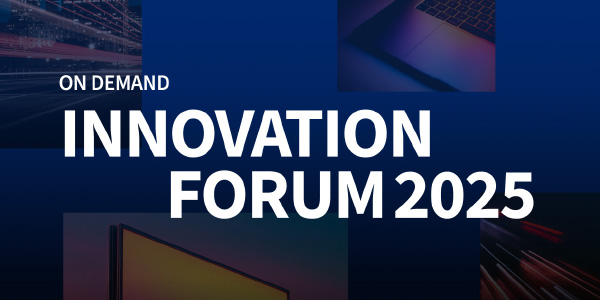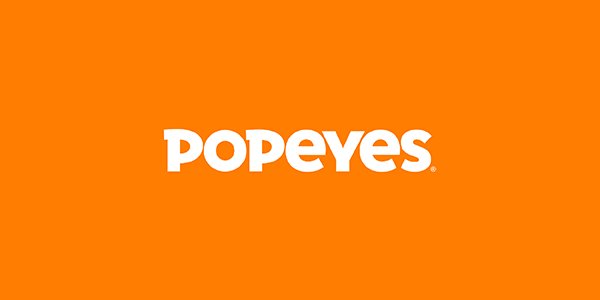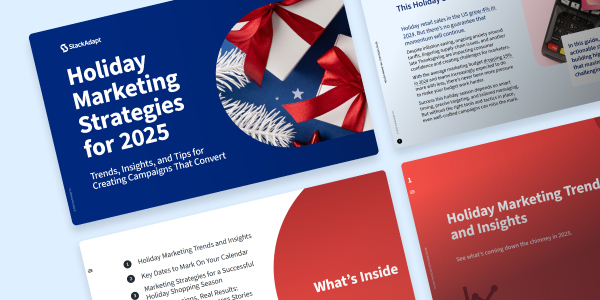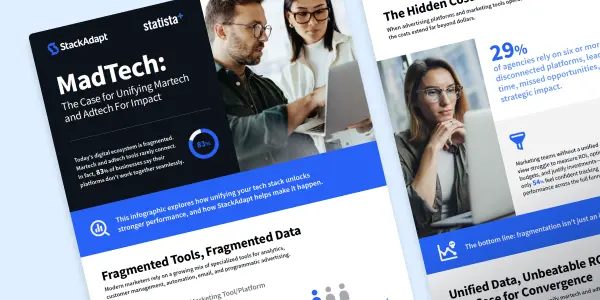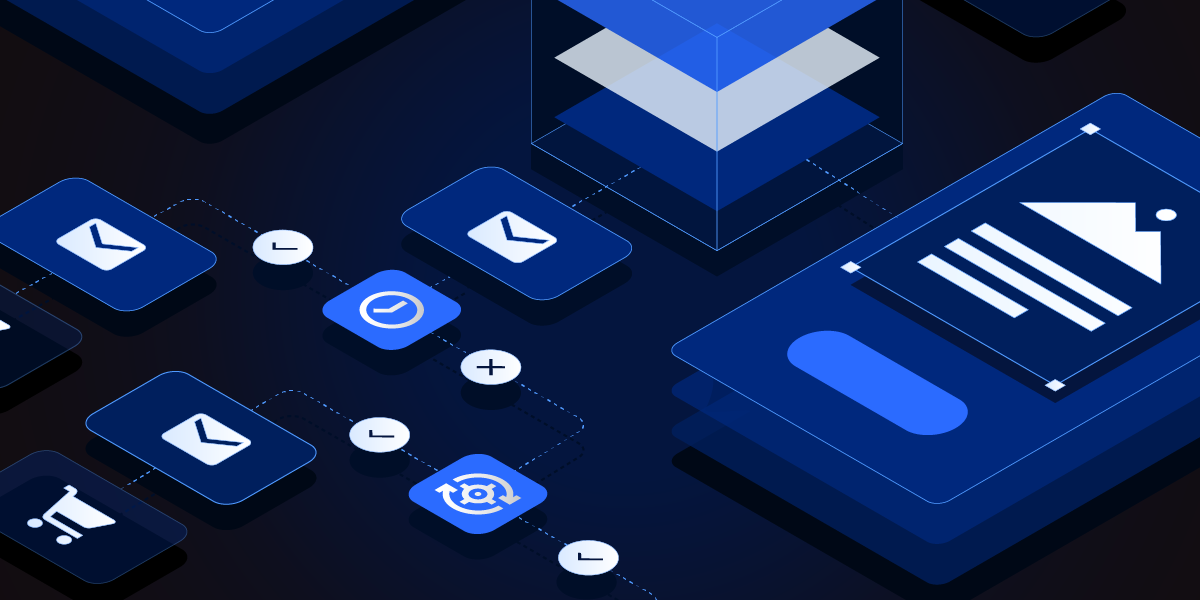The AI Advertising Podcast: S1
Episode 7
How AI Is Changing the Way Marketers Use Martech and Adtech

About This Episode
AI is no longer just a new tool in the marketer’s tech stack—it’s transforming the way we use the stack itself. From campaign planning to performance insights to creative production, generative AI is changing how marketers interact with martech and adtech platforms every day.
Scott Brinker | VP Platform Ecosystem, HubSpot
Winston Zhu | Director of Platform Engineering, StackAdapt)
Transcript
Diego Pineda (00:00:00)
AI isn’t just transforming what marketers can do. It’s changing how they think, how they work, and how they use the tools they rely on every day. Whether it’s launching a campaign, writing a headline, pulling performance data, or planning a multi-channel strategy, AI is reshaping the marketer’s relationship with martech and adtech.
In this episode of The AI Advertising Podcast, we explore how AI is changing the way marketers interact with platforms, collaborate with teams, and build strategy. We’re joined by Scott Brinker, VP of Platform Ecosystem at HubSpot and editor of ChiefMartec, and Winston Zhu, Director of Platform Engineering at StackAdapt. Today, we’ll explore what the next generation of marketing tools looks like, and how smart teams are using AI to do more with less friction.
Podcast Intro (00:00:51)
Welcome to the AI Advertising Podcast, brought to you by StackAdapt. I’m your host, Diego Pineda. Get ready to dive into AI, Ads, and Aha moments.
Diego Pineda (00:01:05)
Let’s kick things off with a closer look at how AI is reshaping the martech landscape, not by adding features, but by introducing a new kind of intelligence that behaves differently than anything marketers have worked with before. Let’s hear from Scott Brinker, who has spent years mapping how marketing technology evolves. He shares a powerful perspective on why generative AI requires a fundamentally different mindset.
Scott Brinker (00:01:31)
Here’s the thing. This technology introduces some very different dynamics into martech. I mean, one of the things about these LLMs and the generative AI engines is they’re not perfectly deterministic. You can ask the same question of the same generative AI engine 10 times and get 10 slightly different answers. Even if all of them are correct to some degree, they’re different—and they differ in subtle ways.
I think also this idea of having more and more of these agents that operate with a certain amount of autonomy and interact with each other… between those two things, you’re talking about introducing almost a new kind of complexity to the martech environment. And I mean complexity in a very scientific term. It’s these multiple independent parts that have interaction effects with each other. And that’s not necessarily a bad thing. In fact, if we actually harness it properly, it can be a really powerful thing.
But it is a very different way of having systems operate than what we’re used to. Everything used to be rule-based, very deterministic—if you put X in, you got Y out. Now, you put X in, and you might get Y, or Y-prime, or Y double-prime. And I think that’s going to require us to rethink not just the architecture of martech stacks, but even more importantly, it requires us to think how we manage these martech stacks, and how we adapt our digital operations and customer engagement strategies given these new capabilities. So there’s a lot to learn.
Diego Pineda (00:03:09)
This shift challenges some of our long-held assumptions. Instead of building systems that respond the same way every time, marketers are now working with platforms that learn, evolve, and sometimes surprise us. That creates more complexity, but also more potential. It’s a new kind of martech stack—one that’s adaptive, flexible, and built to operate in environments that don’t always follow predictable patterns.
Diego Pineda (00:03:40)
At StackAdapt, Winston Zhu is leading the engineering teams building Gen AI directly into the platform, from campaign setup to creative execution.
Winston Zhu (00:03:49)
The most direct impact is really the assets because GenAI people use it to generate assets. Assets means videos, audios, images, text, all of these are assets. So if we can use this to generate assets personally, then StackAdap can also empower GenAI to have advertisers to generate their assets and be used directly. So now we empower users to generate their videos, do background replacement, do image croppings, like offcropping and also multi-sizing as well. So basically, users can upload any type of images to StackAdapt and then StackAdapt will customize their images and all type of assets based on their brand profile, based on the prompt they enter. So like we’ll give them a more modernized, you know, creative for their product or for their brands.
Second one, which is more like behind the scene, is really to use our generative AI to improve their performance of their advertisement campaign. So a campaign can have many, many dimensions that control the campaign. It can have a goal, it can have, you know, how to spend their budget, it can have a timeline. It can have like specific bidding prices and targeted bidding range as well. So all these are configurable. So if you have generative AI that consistently looking at their campaign performance for the last, let’s say, like two or three years, then they can start to use this to change the campaign that’s currently on the flight, which means currently running and to see how we can give the user suggestions to fine tune their campaign so that their campaign can gain a lot of performance.
Diego Pineda (00:05:29)
This evolution isn’t just about features, it’s about changing the role of the user. AI is taking care of the repetitive tasks and giving marketers more space to focus on strategy.
Winston Zhu (00:05:40)
Overall, there are kind of two extremes. So one side of the clients, they really want a fully automated campaign. They are usually like large brands or enterprise customers. They want to say, okay, I want to… run a campaign on a specific product, I define my goal, I define my about budget, then you know I don’t want to care about I run it between 7 to 9 a.m. or i just run it full day. They say, okay, the algorithm can take me there and they optimize on this and I truly trust the algorithm.
However, there’s another extreme of clients, usually are like the agencies dealing with very complex combination of their customers or you know small business clients. So what they want is they want very granular control of their campaign. They want campaign to break down as much as possible. They want to control their campaign to a very specific dimension.
We want to serve both so both clients. So what we’re going to do is we’re going to have our campaign editor at the other side of the platform, be enterprise-driven but also self-serve. We’re going to strike a balance in all of our future products, and make our platform AI-driven behind the scenes. But how we serve to the clients, we might give users different levels of control or interactions to work together with the AI models that we have for the clients.
Diego Pineda (00:07:09)
Winston’s team has also focused on speed and scale: marketers expect results in seconds, not minutes—and across hundreds of variations.
Winston Zhu (00:07:18)
We don’t want users to wait for 30 minutes to generate the image. We don’t want the user to wait for like two minutes to generate a new AI-generated video for their product, which was actually where we were when we first built the model. It was like two minutes that we did the demo. The video was perfect, but the latency or the throughput is something we keep working on. Now it’s like within 20 or 30 seconds for like a full 50-second video.
Diego Pineda (00:07:49)
As AI becomes more deeply embedded into marketing platforms, it’s changing the way work gets done, but not always in the ways you might expect. To understand where AI is driving the most value—and where human marketers are still irreplaceable—I asked Scott Brinker to share his perspective on how the division of labour in martech is evolving.
Scott Brinker (00:08:10)
I think we are looking at greater and greater automation, particularly when it comes to tasks that have a certain, have an algorithm you know, to how they work. I think where we don’t see taking over is sort of on two ends of the spectrum. One end of the spectrum is the actual creative and strategy. I mean, you can leverage AI in helping develop that strategy and creative, but I still think the actual strategy and creative, there’s a lot of subtlety and complexity into that, that, you know, human marketers with deep experience really are the best poised to, you know, be the ones leading.
I mean, as a company, you want that sort of governance and ownership and leadership, you know, from a human marketer. The other place I actually think you also see you know tremendous human-led marketing capabilities, is actually on managing the martech- adtech stack itself. You know like, again, it’s great to have all this technology that can do all this wonderful production work for us, you know but somebody needs to make sure that the actual architecture of how these pieces fit together and how the data is being managed throughout them, you know that that is properly architected and operated. But in between those two poles, when you talk about things that are largely more, again, sort of machine-like, you know, in how they operate. Not saying they don’t need any human supervision, but a lot of the work is something that could get, you know, boiled down into playbooks or more mechanical steps. I think that’s the place where you’re like, wow, okay, AI seems very likely to be able take large portions of that part of the process and just be able to automate it for us.
Diego Pineda (00:09:55)
So while AI is automating more mid-level tasks, like campaign optimization or asset generation, it’s human decision-making that still shapes the stack and defines what success looks like.
That’s something Winston Zhu thinks about every day. He shared how StackAdapt is embedding AI into the platform as a smart layer that drives results behind the scenes.
Winston Zhu (00:10:20)
For our kind of model, so we don’t serve it directly to the clients, meaning we let them to do on the application level, you know, for example, we optimize their campaigns, we generate their creatives. So it’s different from like how users usually think from a ChatGPT perspective, where I need to see and need to give an answer and I need to know how the answer is generated. But here, the user less care about the answer, the user cares about the actual results of their campaign. So what we do is actually we want to find a balance of letting the user give feedback and also let the user see how their campaigns are being optimized based on what reason. I’ll give you an example. For example, if I’m running a CTV ad, but I want this ad to be run so fast, I want to spend my budget immediately. I just put $100 CPM for all my CPS, which, you know of course, will spend your money correctly. But is that the right thing? It’s probably not. It’s not achieving your goal that you really want to solve. So our GenAI model will say, okay, based on the bidding data that we run this campaign for one day, okay, your bid price or your bid price guidance is a little bit too high. So we suggest you put, you know, $25. We won’t make the decision for users. We’re least worried about how this $25 was generated, you know, we’ll use historical data, but the thing we care about is how the user leveraged the results. Because we’re not talking about a chatGPT level of conversation where even if you gave you a wrong answer, no consequences. We’re talking about users spending $100,000 in a campaign that we need the user to have awareness of the results, not to bombard them with, okay, how we calculate this $25. Probably the user doesn’t care. What the user cares about is what is the result. Where is the result generated from? And I’ll make the decision based on my name. I might still want the $100 CPM just because I’m running a prime day or I’m running a rush sales. But it’s all and to end up to the user and we want to respect our user’s decision as well.
Diego Pineda (00:12:34)
And that’s the shift: as more of the execution gets automated, the role of the marketer becomes even more strategic. Choosing when to trust AI—and when to override it—might just be the new competitive advantage.
Scott Brinker (00:12:52)
Well, we’re in an environment where things are changing very rapidly. So if I were going to future-proof anything, in almost a somewhat abstract way, I’d say you want to focus on your ability to change. There are actually things you can do. Like when you think about how you’re designing your martech stack and which products you’re adopting, are they open? Do they have open APIs? Do they allow it to fit into an ecosystem where you can add new things or remove new things relatively easily? Because even if you don’t necessarily know today what you’re going to want to add and remove a year from now, you can be pretty sure there are going to be things you’re going to want to add or remove a year from now. And so if you’ve designed your stack in a way that makes that easier, I think that is a true competitive advantage.
You know, so, I mean, there’s also the way we think about, you know, from a management perspective, you know, we don’t talk a lot about agile marketing or agile management anymore, but really a lot of those principles, you know, are as applicable now as they ever were, which is how do we run our teams in a way where they can possibly learn and adapt much more quickly in this AI environment than they ever could have before? so and don’t know, sort of leaning into the ability to change and react to change quickly. think one of the best ways to future-proof your business.
Diego Pineda (00:14:12)
The future stack is leaner, smarter, and more intuitive. But it still needs humans in the loop to guide the vision, ask better questions, and course-correct when needed.
Diego Pineda (00:14:25)
So here’s where we land: AI is changing the way marketers use technology. It’s breaking down complexity. It’s speeding up decision-making. And it’s creating new expectations for how tools should work.
Don’t wait for a new platform, look at the AI already inside the tools you use. Shift from task-based workflows to outcome-based thinking. Let AI handle the friction, so you can focus on the strategy.
Podcast Outro (00:14:51)
Thanks for listening to this episode of The AI Advertising Podcast. This podcast is produced by StackAdapt. Visit us at stackadpat.com for more information about using AI in your advertising campaigns. If you liked what you heard, remember to subscribe, and we’ll see you next time.
